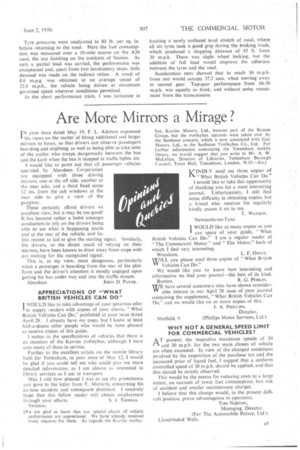Are More Mirrors a Mirage?
Page 41

If you've noticed an error in this article please click here to report it so we can fix it.
I N your issue dated May 19, F. L. Aikman expressed his views on the matter of fitting additional and larger mirrors to buses, so that drivers can observe passengers boarding and alighting, as well as being able to take note of the cyclist who creeps dangerously between the bus and the kerb when the bus is stopped at traffic lights, etc
I would like to point out that all passenger vehicles operated by Aberdeen Corporation are equipped with three driving mirrors, one at the off side, another at the near side, and a third fixed some 12 ins, from the cab windows at the near side to give a view of the gangway.
These certainly afford drivers an excellent view, but it may be too good! It has become rather a habit amongst conductors to rely on the drivers being able to see what is happening inside and at the rear of the vehicle_ and foi this reason to fail to give the starting signal. Similarly, the drivers, as the direct result of relying on their mirrors, have been known to draw away from stops with out waiting for the recognized signal.
This is, in my view, most dangerous, particularly when a passenger is boarding from the rear of the platform and the driver's attention is mostly engaged upon getting his bus under way and into the traffic stream.
Aberdeen JOHN D. PAYNE.
APPRECIATIONS OF "WHAT BRITISH VEHICLES CAN DO" WOULD like to take advantage of your generous offer to supply readers with copies of your charts, " What British Vehicles Can Do," published in your issue dated April 28. 1 already have my copy, but I know at least half-a-dozen other people who would be most pleased to receive copies of this guide.
notice in the specifications of vehicles that there is no mention of the Karrier trolleybus, although I have seen many of these in service.
Further to the excellent article on the mobile library built for Tottenham, in your issue of May 12, I would be glad if you could tell me who could give me more detailed information, as I am almost as interested in library services as I am in transport.
May I add how pleased I was to see the prominence you gave to the letter from E. Moriarty concerning his curious accident and subsequent dismissal. I sincerely hope that this fellow reader will obtain employment through your efforts. S. J. THOMAS. Swinton.
Me are glad to learn that our special charts of vehicle performance are appreciated. We have already received many requests for them. As regards the Karrier trolley
bus, Karrier Motors, Ltd., became part of the Rootes Group, but the trolleybus interests were taken over by the Sunbeam concern, which is now associated with Guy Motors, Ltd., as the Sunbeam Trolleybus Co., Ltd. For further information concerning the Tottenham mobile library, we would suggest that you write to Mr. A. W. McLellan, Director of Libraries, Tottenham Borough Council. Town Hall, Tottenham, London. N.15.—ED.] VINDLY send me three copies of
11`
"What British Vehicles Can Do."
('would like to take this opportunity of thanking you for a most interesting journal. Unfortunately, I still find some difficulty in obtaining copies, hut a friend who receives his regularly kindly passes it on to me.
T. WATSON.
Newcastle-on-Tyne.
I WOULD like as many copies as you can spare of your guide, "What British Vehicles Can Do." I am a regular reader of The Commercial Motor" and "The Motor," both of which I find very interesting.
Wrexham.
WILL you please send three " Vehicles Can Do."
We would like you to know how interesting and informative we find your journal--tlie best of its kind.
Buxton. R. G. PERKIN. have several customers who have shown considerable interest in our April 28 issue of your journal containing the supplement, "What British Vehicles Can Do,and we would like six or more copies of this.
L. F. OWEN.
copies of "What British J. A. PHILLIPS, Director, (Phillips Motor Services, Ltd.). Sheffield, 9.
WHY NOT A GENERAL SPEED LIMIT FOR COMMERCIAL VEHICLES?
AT present, the respective maximum speeds of 20 and 30 m.p.h. for the two main classes of vehicle are often exceeded. In view of the changed conditions involved by the imposition of the purchase tax and the increased price of liquid fuel, I suggest that a uniform controlled speed of 30 m.p.h. should be applied, and that this should be strictly observed.
This would be the means for reducing costs to a large extent, on account of lower fuel consumption, less risk of accident and smaller maintenance charges.
I believe that this change would, in the present difficult position, prove advantageous to operators.
Tom NORTON, Managing Director.
(For The Automobile Palace, Ltd.). Lla ndrindod Wells.












































































